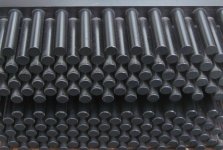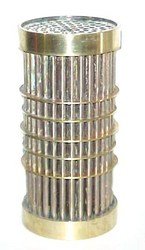Good thought Hannes. I will look into it.Nice amp!
Might be a small grounding issue.
Hannes
Thanks
Thanks Bear
The heatsink idea was not mine.. I got the idea from the Burning amp chassis that were given away at burning amp a while ago..
Each tube is attached using 2 screws from the inside of the tube into the back plate..
🙂
Given away by?
Mr. Pass or some other person.
Don't think I have seen that one before... not sure why I did not come up with it, but it may be that the extrusions in that shape are actually fairly expensive compared to some others and other solutions...
Would like to give credit.
_-_-bear
probably not the thread for this, but a D shape would not be too good unless the "|" part of the D was kinda short and the ")" part was stretched out and not a semi circle...
_-_-bear
_-_-bear
Given away by? ...Don't think I have seen that one before... not sure why I did not come up with it,...Would like to give credit.
_-_-bear
Check out the PLH article. I saw it there first 😀
make a neat heatsink.
Best and prettiest heatsink for DIY.
(rods are shrunk in the base plate holes, easy peasy to do at home with an oven and a zero-F freezer, then anodize)
Attachments
😱...Whats dat masochist cooling by Jacco................

masochism would be drilling all them holes 😱
altering the f5 sound
Hi,
as written from NP - how can i alter the sound to make it less bright (only a little bit) actually i´m using irf´s output fets and i will keep the single pair.
Hi,
as written from NP - how can i alter the sound to make it less bright (only a little bit) actually i´m using irf´s output fets and i will keep the single pair.
Paralleling output devices will change the measured performance in various
ways. One thing it will usually do is increase the open loop gain, and the
other is that it will make it slower. Assuming that these do not cause some
instability (and modifying an F5 you have to watch out for that), there are
some general rules for how the sound changes.
The spectral balance between bass and treble will alter. The amp will seem
to have more bass and more power and control in the bass region. The
treble will recede a bit, and the overall tone of the amplifier will get darker.
This is not necessarily a bad thing. Usually there is a "best" balance between
light and dark, as with the Alephs. The 3 was a bit shiny, the 1.2 was
comparatively dark. For me, the 2 was just right.
The stock F5 circuit is a little shiny. Paralleling up outputs might help your
perception of the amplifier.
Also, the use of different outputs, in your case, the IRFP9240 will
substantially alter the tone. Again, you may prefer it - some people do.
😎
The answer seems to be into the question.
"The stock F5 circuit is a little shiny. Paralleling up outputs might help your
perception of the amplifier."
"The stock F5 circuit is a little shiny. Paralleling up outputs might help your
perception of the amplifier."
vtr,
Increase feedback resistors R9-12 to 200R and source resistors R3/R4 to 20R (R1 schematic). It will produce a warmer sound as well as increase output volume
Increase feedback resistors R9-12 to 200R and source resistors R3/R4 to 20R (R1 schematic). It will produce a warmer sound as well as increase output volume
Change resistors to carbon will alter the balance of the sound quite a lot (gate stoppers, main I/V, f/back, power fet sources) plus using soft recovery diodes, Elna power caps, and increasing the 'R' in the C-R-C power supply (or use a choke), multi-stranded wiring, etc will all contribute to a "softer" sound - there's no end to the combinations.
Also, early on in this thread, "jackinj" did a sim design with input resistors and caps, and you can also use "juma" BF862 for an input gain stage that can be setup for a "softer" sound, or you could even build an input valve gain stage like in the Moskido ......
Also, early on in this thread, "jackinj" did a sim design with input resistors and caps, and you can also use "juma" BF862 for an input gain stage that can be setup for a "softer" sound, or you could even build an input valve gain stage like in the Moskido ......
thanks this sounds good
as i would like to keep my single pair output irf´s i´ll try to reduce feedback-any stabilty problems with half the feedback?
i use the original schematic and will take out one 100r feedback resitor
and i use already a choke input supply, and i keep my solid cables i avoid stranded wire whereever possible as i trust Allen wright principles
as i would like to keep my single pair output irf´s i´ll try to reduce feedback-any stabilty problems with half the feedback?
i use the original schematic and will take out one 100r feedback resitor
and i use already a choke input supply, and i keep my solid cables i avoid stranded wire whereever possible as i trust Allen wright principles
vtr,
Increase feedback resistors R9-12 to 200R and source resistors R3/R4 to 20R (R1 schematic). It will produce a warmer sound as well as increase output volume
as i would like to keep my single pair output irf´s i´ll try to reduce feedback-any stabilty problems with half the feedback?
i use the original schematic and will take out one 100r feedback resitor
The F5 is right on the edge of what of how much feedback you can use
without compensation capacitors. Reducing the feedback on it won't
hurt it at all.
Hi people!
I'd say that is definitely the ultimate schematics of the audio amplifier F5.
Place the schematic here and move on.
On which side of this post I can see a picture made amplifiers F5?
thanks and cheers
I'd say that is definitely the ultimate schematics of the audio amplifier F5.
Place the schematic here and move on.
On which side of this post I can see a picture made amplifiers F5?
thanks and cheers
Last edited:
HiOye hombre, no tiene ninguna idea qué tú dices, no ?
I'd write in English to understand the other id.
Thanks
Hi
I'd write in English to understand the other id.
Thanks
Sorry, I don't understand what you [2] are talking about
LOL
any stabilty problems with half the feedback?
Don't forget that your amp's gain will increase accordingly. Hannes
- Home
- Amplifiers
- Pass Labs
- F5 power amplifier

